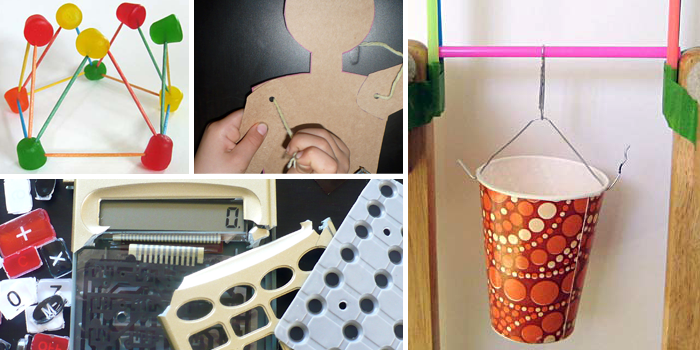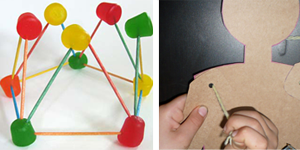Unleash the Engineer in You: Tackle Everyday Problems with STEM Projects
If something doesn't work the way you think it should, can you fix it? If troubleshooting problems or potential trouble spots is something you enjoy, you can satisfy your engineering itch and increase your STEM skills with a wide range of hands-on projects that can be done at home. These projects make for great weekend or summer explorations. After you finish, you may be able to wow your friends and family with cool devices, tweaks, hacks, and fixes! Plus, you will be building marketable engineering skills for the future.

Do you spend time trying to figure out how to fix and improve things around your house? Do you sometimes have ideas for new products that you think would really solve this or that problem on a real-world, totally-useful, ground level—a problem in the kitchen, the way your cell phone screen has shattered twice from simple falls, an issue with locker storage space at school, the way your sibling's new toy broke after only a few hours?
If finding ways to fix small but annoying problems at home, or looking for ways to solve or improve frustrating problems with things you buy, presents a perfect puzzle for you, projects like these may be perfect for channeling your natural problem-solving and innovation skills into an engineering-focused exploration with a useful outcome.
You don't have to have a science fair coming up. All of these science and engineering projects can easily be done as cool activities at home just because you enjoy the challenge and like to make things better. You may come up with something that solves a real-world problem!
- Crash! Can Cell Phones Survive a Drop Test?: make your own cases for calculators (or some other household item or toy) and experiment with "drop tests" to learn more about how products are tested and improved by product engineers.
- Stretchy Rubber Band Science: have you ever grabbed a rubber band and found it so brittle that it snapped when you tried to use it? If you are using rubber bands for a homemade (or wooden) rubber band launcher, or for a rubber band-based game, understanding how temperature affects rubber bands (and why) can be really important. Should you keep a rubber band stash out of the summer heat, or is summer heat exactly what you need for maximum stretch in your rubber bands? Find out with an interesting physics exploration!
- Moving Water with the Archimedes Screw Pump: can you easily move water from one place to another using a homemade device that you simply twist? Experiment with a classic design by building your own Archimedes screw pump from ordinary materials. Can you improve the pump design to make it more efficient?
- Get Crafty — Create Your Own Durable Paper Doll: experiment with paper dolls to find ways to make them less likely to tear or break during play. Kids are tough on their toys! Can you come up with new approaches to the design or assembly that improve durability without changing the play value?
- Build a Gumdrop Geodesic Dome: build a geodesic dome from simple candies and toothpicks to see how math and physics combine in this structure. How strong is a geodesic dome? What variables influence its strength? What happens when you increase the scale of a geodesic dome and make it larger? What other materials can you try, and how can you put this structure's strength and durability to the test?
- Bridge Building Bonanza: Which Design Wins?: experiment with different kinds of bridge structures to explore questions related to materials, design, and stability.
- Keeping It Private: Blocking RFID Readers from Reading your ID Card: learn more about RFID technology and how RFID readers can be used to access information without someone realizing it. In this project, experiment to find out which materials can be used to help protect RFID information, data stored on an ID card, for example, and design your own protective case or barrier. Your project might change how you think about the information you (or your family members) carry in a pocket or bag!
- Applying Hooke's Law: Make Your Own Spring Scale: Make Your Own Spring Scale: make your own spring scale to learn more about this physics principle, and then put it to use around the house to try it out! You will need assorted household materials to build your scale, including a couple of different springs to try. You might even find what you need in the closet or toy box.
More Hand-on Summer Challenges
For even more fun engineering and electronics challenges this summer, take a look at the following projects and resources:
- Flippy the Robot Dances (and Falls Apart)
- Cellphone Microscope: Turn a Phone Into a Functional Piece of Scientific Medical Equipment (Science-hack Your Phone: Part 1)
- Cellphone Spectrophotometry: Turn a Phone Into a Functional Piece of Science Equipment (Science-hack Your Phone: Part 2)
- Dance Mania: Build Your Own Dance Pad!
- LED Traffic Glove: Build a Safety Device to Direct Traffic
- Marble Machine
- Balloon-Powered Car Challenge
A Career in Science, Technology, Engineering, and Math
If you enjoy tackling DIY projects and challenges like the ones listed above, you may want to learn more about STEM careers like these:
- Electrical Engineering Technician
- Mechanical Engineering Technician
- CAD Technician
- Civil Engineering Technician
Not every STEM career requires a four-year or advanced degree. Express Employment Professionals is a company committed to helping job seekers of all ages, including students just entering the job market, locate exciting jobs in areas of interest. Through online resources and a series of Job Genius videos, Express Employment Professionals helps prepare, coach, and guide students through the job seeking and interview process. Learn more on the Express Employment Professionals site.
See also, Exploring, Finding, and Landing STEM Careers.
Categories:
You Might Also Enjoy These Related Posts:
- Plastics and Earth Day - Science Projects
- Arduino Science Projects and Physical Computing
- 10+ Robotics Projects with the BlueBot Kit
- 5 STEM Activities with Marshmallow Peeps
- March Madness Basketball Science Projects: Sports Science Experiments
- Women in STEM! More than 60 Scientists and Engineers for Women's History Month
- Explore Artificial Intelligence and Machine Learning with Student AI Projects
- 10 Reasons to Do the Rubber Band Car Engineering Challenge










